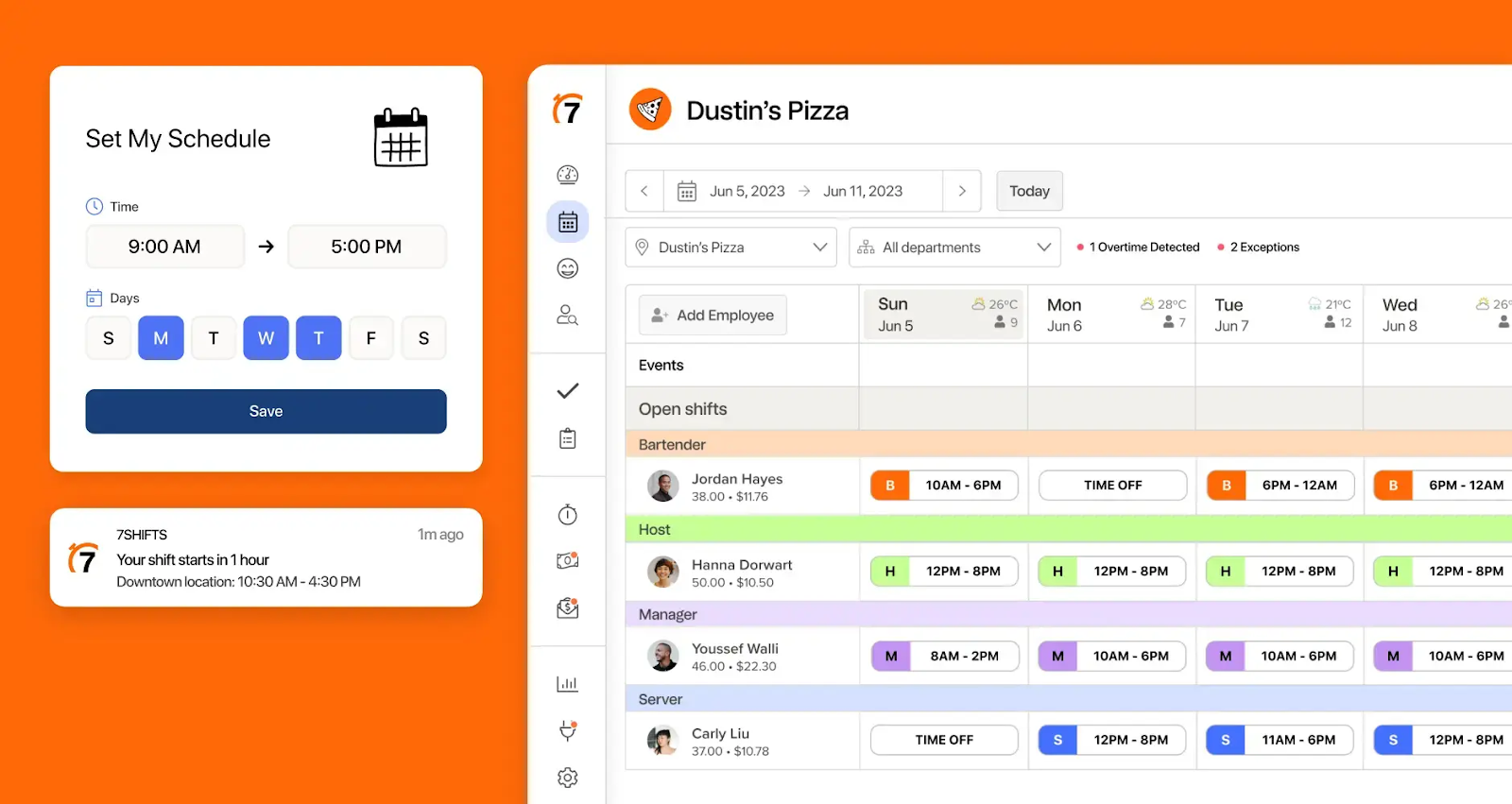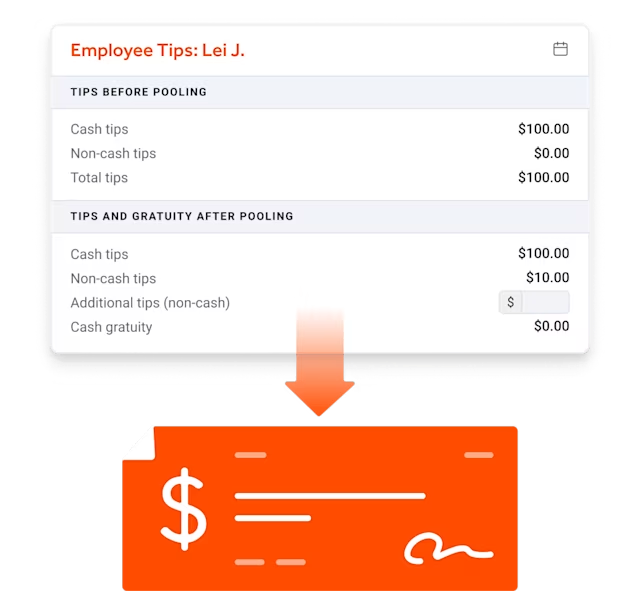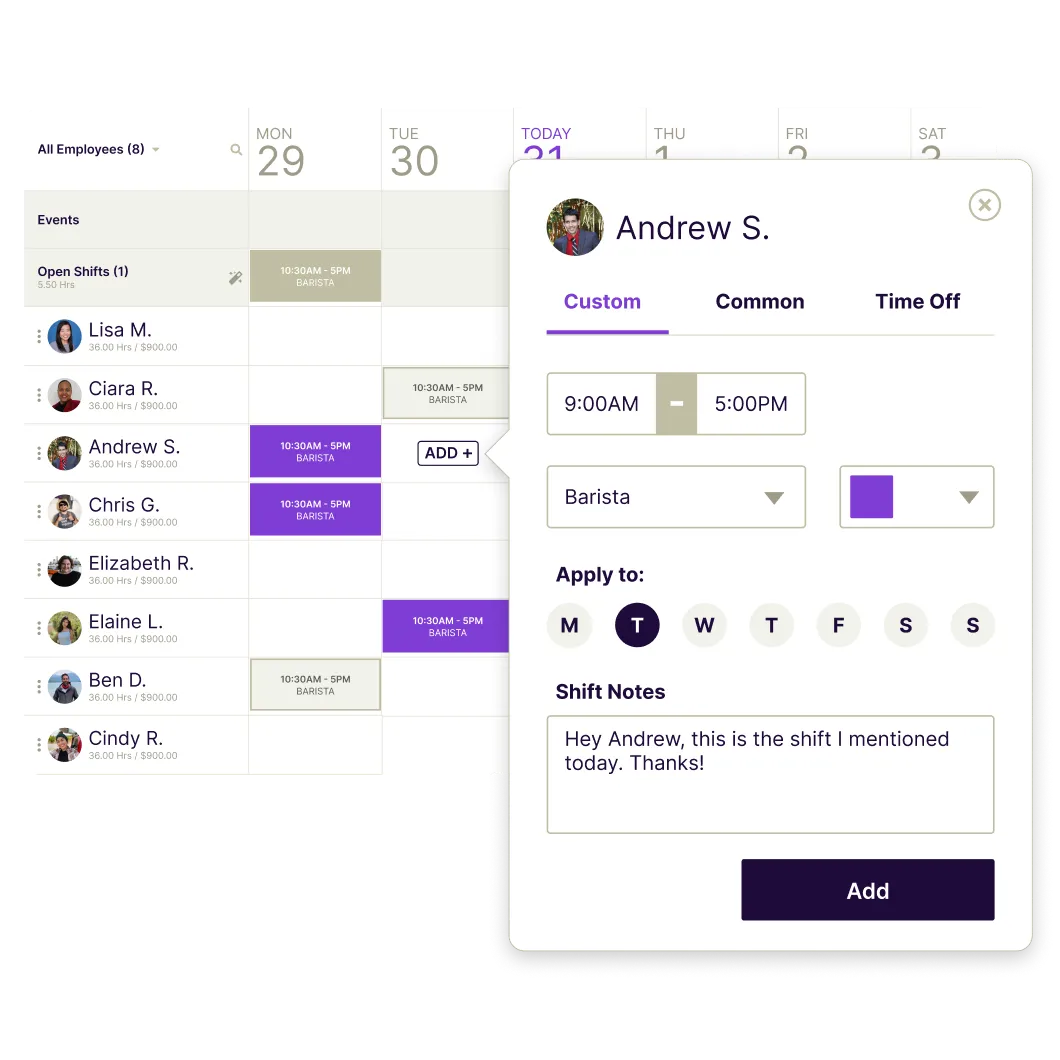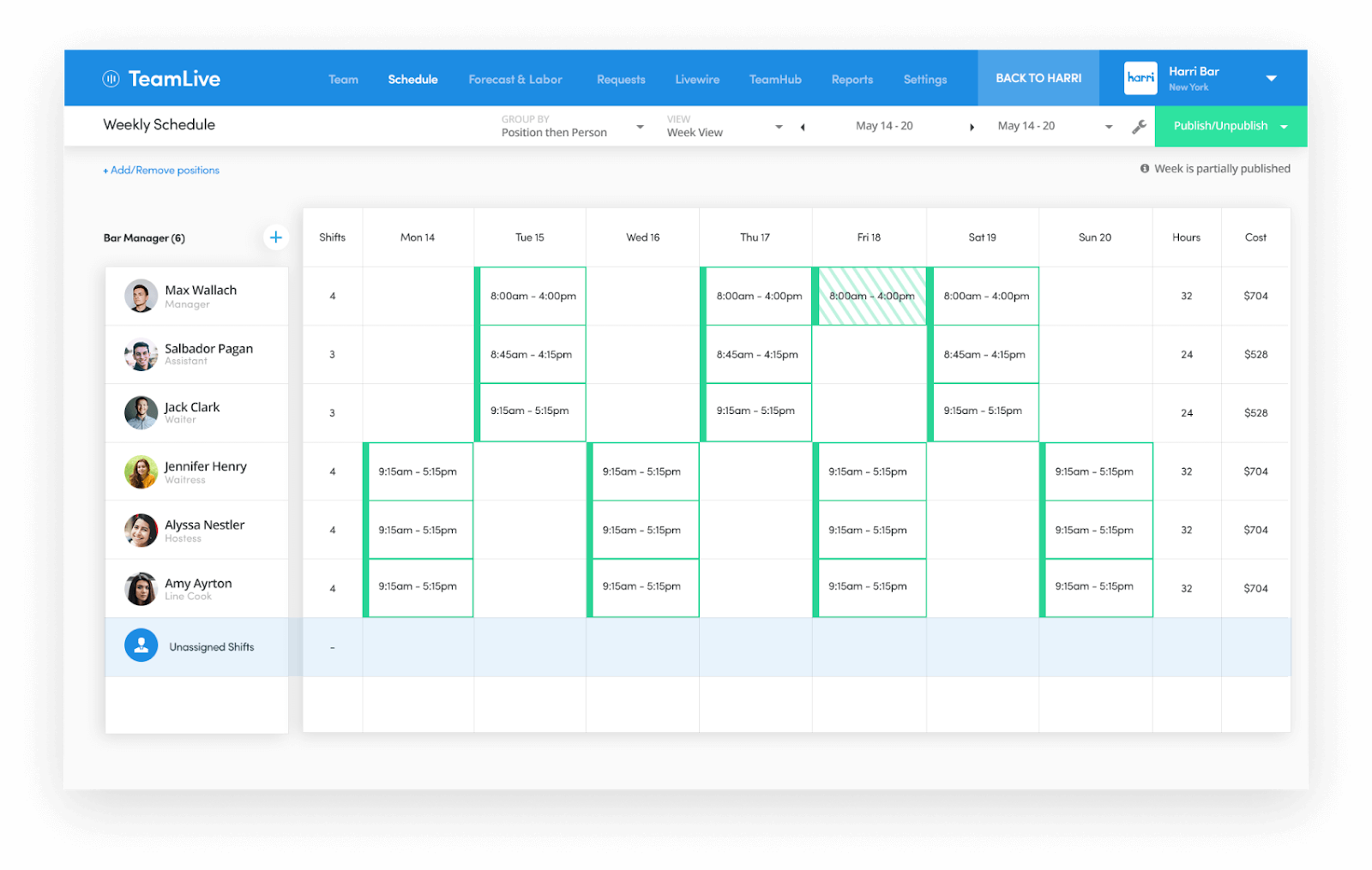
Managing a restaurant often includes dealing with non-stop staffing challenges. Between unexpected no-shows during dinner rush, tip calculations that turn into mathematical puzzles, and ever-evolving compliance requirements, traditional business management software tends to fall short.
Generic HR software assumes you have predictable schedules and straightforward hourly wages. In reality, your server might work a double shift spanning breakfast and dinner, earn different rates for training new hires, and split tips with the kitchen crew—all while you're trying to cover for someone who called in sick.
Restaurant HR software handles these industry-specific challenges without creating new headaches. Instead of spending hours manually calculating payroll or coordinating schedules through endless group texts, you get tools designed specifically for how restaurants operate.
This guide helps you pick restaurant HR software that actually makes your life easier—not more complicated.
TL;DR: Choosing the right restaurant HR software
Restaurant HR software helps remove the manual chaos of managing tip calculations, variable schedules, and compliance requirements that other business tools can't handle.
Key features to prioritize: Integrated tip management, mobile-friendly scheduling with shift swapping, automated compliance alerts, and seamless payroll processing that understands restaurant pay structures.
Top options for different needs:
- Budget-conscious smaller restaurants: Homebase offers excellent free tools with room to grow
- Labor cost control focus: 7shifts provides detailed analytics and forecasting
- POS integration priority: Toast Payroll works seamlessly with existing Toast systems
- Complex HR requirements: Harri serves medium to large operations with comprehensive features
Quick selection process: Identify your biggest operational pain point, test 2-3 platforms with free trials, and prioritize systems your team will actually use over feature-heavy platforms they'll ignore.
The right restaurant workforce management software should reduce your administrative workload pretty quickly.
{{banner-cta}}
What is restaurant HR software?
Restaurant HR software helps handle the unique workforce management challenges that restaurants face every day. These tools understand the complexities of tip distribution, variable schedules, and food service compliance requirements.
Restaurant HR software typically combines several essential functions into one platform:
- Payroll and tips management handles everything from calculating split tips to processing direct deposits while staying compliant with wage laws.
- Shift scheduling and attendance tracking lets you create schedules that actually work, with easy shift swapping and real-time clock-in capabilities.
- Labor compliance keeps you on the right side of break requirements, overtime rules, and minimum wage regulations that vary by location.
- Employee onboarding and offboarding streamline the hiring process with digital paperwork and training modules.
- Finally, workforce analytics and reporting give you insight into labor costs, turnover patterns, and scheduling efficiency.
Why restaurants need specialized HR software
Restaurant operations require fundamentally different HR approaches than typical businesses. Here's why the food service industry needs purpose-built solutions.
- Industry-specific labor laws and compliance requirements create a complex regulatory environment that standard HR software can't navigate. Restaurants must manage complex tip credit calculations, overtime rules for tipped employees, and break requirements that differ by state. For example, both California and Colorado require 30-minute meal breaks for shifts over 5 hours and 10-minute rest breaks every 4 hours, while many other states have no break requirements at all. Restaurant payroll software understands these nuances instead of treating every employee like a standard hourly worker.
- High employee turnover and seasonal staffing complexities pose constant challenges that generic systems can't handle efficiently. According to the U.S. Chamber of Commerce, the hospitality industry has a quit rate of 4.1%—nearly double the rate of wholesale and retail at 2.3%. This means you're constantly onboarding new team members while managing fluctuating staff levels during busy seasons or unexpected departures.
- Accurate, efficient handling of tips, split shifts, and varying pay rates requires specialized calculations that standard payroll systems simply can't process. When your server works both front-of-house and kitchen duties in the same shift, or when tips need distribution among multiple team members based on hours worked, you need restaurant-specific payroll for restaurants that understands these complexities.
- Efficient scheduling to optimize labor costs against fluctuating demand becomes critical when your lunch rush requires twice the staff of your dinner service. Restaurant workforce management software helps you match staffing levels to actual customer traffic patterns instead of relying on guesswork and hoping for the best.
Key features restaurant owners should look for in HR software
The right restaurant HR software should handle your biggest operational headaches without creating new ones. Focus on these core features that actually matter for restaurant operations.
Payroll and tips management
Your restaurant payroll system should create a seamless flow from time tracking to employee paychecks without the manual calculations that eat up your weekends.
- Look for direct deposit payroll processing that handles the complex calculations restaurants require. Your system should automatically calculate different pay rates for the same employee working multiple positions, handle tip credits correctly, and process payments without manual intervention.
- Integrated tip management and allocation saves hours of manual calculations. The best restaurant payroll software distributes tips based on hours worked, sales volume, or custom allocation rules you set. No more spreadsheets or arguments about who gets what.
- Overtime or holiday pay calculations become automatic instead of error-prone manual processes. The system should understand restaurant-specific overtime rules, including how tips affect overtime calculations and when double-time applies.
- Tax withholding and reporting automation keeps you compliant without the paperwork nightmares. Quality HR payroll software restaurant solutions handle federal, state, and local tax requirements while generating the reports your accountant actually wants to see.
Scheduling and attendance tracking
Restaurant scheduling software should eliminate the chaos of constant schedule changes and last-minute coverage issues.
- Easy shift scheduling and swapping via mobile apps puts control in your employees' hands while maintaining your approval authority. Staff can claim open shifts, request time off, and arrange trades directly through their phones, reducing the endless texts and calls that interrupt your day.
- Real-time attendance tracking with GPS clock-in features prevents time theft while giving you accurate labor data. The best systems use geofencing to ensure employees can only clock in from your restaurant location.
- Labor forecasting tools to optimize staffing help you schedule the right number of people based on historical sales data and projected demand. Instead of over-staffing slow days or getting slammed understaffed, you get data-driven scheduling that matches labor costs to actual revenue.
Employee onboarding and training
Streamlined onboarding transforms the paperwork nightmare of new hires into a smooth digital process.
- Digital onboarding and HR document management handles everything from I-9 forms to emergency contacts through secure cloud storage, eliminating lost paperwork during busy periods.
- Compliance training modules cover food safety, harassment prevention, and other required training that keeps you legally protected. The best restaurant operations software tracks completion and sends reminders for renewal dates.
Labor compliance and legal safeguards
Built-in compliance monitoring acts as your early warning system for potential labor law violations.
- Built-in labor law compliance automatically enforces break requirements, overtime rules, and minimum wage alerts based on your location. The system should understand both federal and local labor laws that apply to your restaurant.
- Automated alerts for compliance issues or potential violations warn you before problems become expensive lawsuits. Quality HR software for restaurants flags issues like missed breaks, potential overtime violations, or scheduling conflicts before they occur.
Reporting and analytics
Comprehensive reporting transforms your operational data into actionable insights for better decision-making.
- Labor cost tracking against sales data shows you exactly how much you're spending on labor as a percentage of revenue. This insight helps you optimize scheduling and identify when labor costs are getting out of control.
- Turnover and retention reporting reveals patterns in employee departures, helping you spot systemic issues before they escalate into bigger problems.
- Payroll summary reports for simplified accounting provide clean, organized data that makes tax time less painful. Your accountant will thank you for reports that actually make sense instead of confusing spreadsheets.
How to choose the best restaurant HR software for your business
Picking restaurant HR software doesn't have to feel overwhelming. Follow these steps to find a system that actually works for your restaurant.
1. Identify your restaurant's biggest HR pain points.
Are you spending too much time on payroll calculations? Struggling with last-minute schedule changes? Worried about compliance violations? Start with the problems that cost you the most time or money right now.
If payroll takes 4 hours weekly at $25/hour, that's $5,200 annually just in manager time. Quantifying your expenses in detail helps you understand our budget for HR software and which problems to prioritize.
2. Decide on "must-have" features.
Create two lists: problems that cost you money and problems that create compliance risk. Money problems include inefficient scheduling that leads to overstaffing, manual tip calculations that eat manager time, and high turnover from poor communication.
Compliance risks include missed break tracking, overtime violations, and improper tip credit calculations. Your must-have features should directly address your highest-cost and highest-risk items first. Don't get distracted by fancy features you'll never use.
3. Check ease-of-use and employee-friendliness.
Test the software with your actual team during a trial period. Can your least tech-savvy employee clock in without help? Can staff easily swap shifts during a busy dinner service?
Watch for red flags like complex multi-step processes for basic tasks or interfaces that require training. If employees can't figure it out quickly, they'll work around the system instead of using it.
4. Assess integration capabilities with your POS and accounting software.
Map out your current data flow from sales to payroll to accounting. Quality integration means sales data automatically flows to scheduling forecasts, time clock data feeds directly into payroll, and payroll totals export cleanly to your accounting system.
Ask vendors for specific integration details—not just "yes, we integrate" but how the data actually transfers and what manual steps remain.
5. Request personalized demos or short trials of your top 2-3 options.
Come prepared with real scenarios: your typical tip distribution structure, your most complex employee who works multiple roles, your busiest shift change. Ask the vendor to walk through exactly how their system would handle these situations.
During trials, process at least one full payroll cycle and test the mobile app during actual service. Most importantly, get your team's honest feedback—they'll be the ones using it daily.
Brief overview of popular restaurant HR software
Here's the real scoop on the most popular restaurant workforce management software options, based on what actually works for different types of operations.
7shifts

7shifts built their entire platform around restaurant scheduling, and it shows. This isn't generic business software trying to work for restaurants—it's designed specifically for the chaos of shift work and variable staffing needs.
7shifts is designed specifically for restaurant operations, serving everything from small independent establishments to large chains across various food service segments. The platform excels at labor cost control with real-time reporting that shows exactly how your staffing costs stack up against sales. The mobile app makes shift swapping painless, and employees can handle most scheduling requests without bothering managers during busy periods.
Best for: Restaurants struggling with labor costs or complex scheduling needs. The analytics help you optimize staffing levels instead of guessing.
Pricing: Free plan covers basic scheduling and restaurant team communications for up to 20 employees. Paid plans start at $39.99 per location per month.
Toast Payroll & Team Management

Toast takes a different approach by integrating payroll directly with their POS system. If you're already using Toast for transactions, their payroll extension eliminates the data transfer headaches between systems.
The tip distribution automation handles complex pooling scenarios automatically, and compliance monitoring helps prevent costly labor violations. Toast's scheduling capabilities provide integrated shift management that syncs directly with POS data and time tracking.
Best for: Restaurants already using Toast POS or those wanting tight integration between sales data and payroll processing.
Pricing: Toast Payroll + POS bundle starts at $69/month plus $9/employee/month. Custom pricing available for select features.
Homebase

Homebase stands out with genuinely useful free tools that smaller restaurants can use indefinitely. The basic plan includes scheduling, time tracking, and team communication—enough to solve major operational headaches without monthly fees.
The employee mobile app gets consistently high marks for being actually usable during shifts. Payroll integration simplifies the entire process from time tracking to direct deposit, and the compliance alerts help prevent overtime violations before they happen.
Best for: Smaller establishments looking for free basic tools or restaurants wanting user-friendly software that employees will actually adopt.
Pricing: Free forever plan for basic features (scheduling, time tracking, POS integration) for one location with up to 10 employees. Paid plans start at $24/location/month for unlimited employees. Payroll available as an add-on.
Harri

Harri built their platform specifically for hospitality businesses with complex HR needs. They focus on medium to large operations that need comprehensive onboarding, detailed compliance tracking, and advanced performance management tools.
The system includes robust applicant tracking and recruitment modules, which help with the constant hiring challenges restaurants face. Employee engagement tools and training modules support retention efforts beyond just scheduling and payroll.
Best for: Medium to large restaurants with complex HR requirements and dedicated staff to manage the system.
Pricing: Custom pricing only—you'll need to request a quote based on your specific needs and restaurant size.
FAQs about choosing restaurant HR software
Which software is best for restaurant management?
The best restaurant management software depends on your specific needs and size. For comprehensive operations management, platforms like Toast offer tight POS integration. For labor cost control, 7shifts excels with detailed analytics. For budget-conscious smaller restaurants, Homebase provides excellent free tools with room to grow.
What is the best restaurant software?
Restaurant software takes care of more than just HR—it includes POS systems, inventory management, and customer-facing tools. For HR specifically, focus on platforms that handle your workforce challenges first, then consider how they integrate with your existing tech stack.
The best overall restaurant software solution combines effective HR management with seamless POS integration, which is why many operators choose platforms like Toast for comprehensive coverage or pair specialized HR tools like Homebase with their preferred POS system.
What is the best restaurant scheduling software?
7shifts and Homebase both excel at scheduling but serve different needs. 7shifts provides detailed labor analytics, sales forecasting, and advanced reporting that help optimize staffing costs. Homebase offers simpler, more intuitive scheduling with excellent mobile apps that employees actually want to use. Both platforms handle shift swapping and time-off requests effectively, so your choice depends on whether you prioritize analytical depth or ease of use.
Is 7shifts only for restaurants?
Yes, 7shifts is designed specifically for restaurant operations and serves everything from small independent establishments to large restaurant chains. They serve various segments within the restaurant industry including bakeries, bars, cafes, catering companies, pizzerias, and franchises.
Simplify HR, payroll, and scheduling to grow your restaurant
The right restaurant HR software eliminates the administrative chaos that keeps you stuck in the back office instead of focusing on great food and customer experience. Look for platforms that understand restaurant-specific challenges like tip distribution, variable scheduling, and complex compliance requirements.
Start with your biggest pain point—whether that's payroll headaches, scheduling chaos, or compliance concerns—and choose software that solves that problem first. Focus on ease of use over fancy features. The best payroll systems for restaurants are the ones your team will actually adopt and use consistently. You can always add features later as your business grows.
Ready to streamline your restaurant operations? Try Homebase today and see how the right tools can transform your daily restaurant management.
{{banner-cta}}
Share post on

Homebase Team
Remember: This is not legal advice. If you have questions about your particular situation, please consult a lawyer, CPA, or other appropriate professional advisor or agency.
Popular Topics
Homebase is the everything app for hourly teams, with employee scheduling, time clocks, payroll, team communication, and HR. 100,000+ small (but mighty) businesses rely on Homebase to make work radically easy and superpower their teams.




